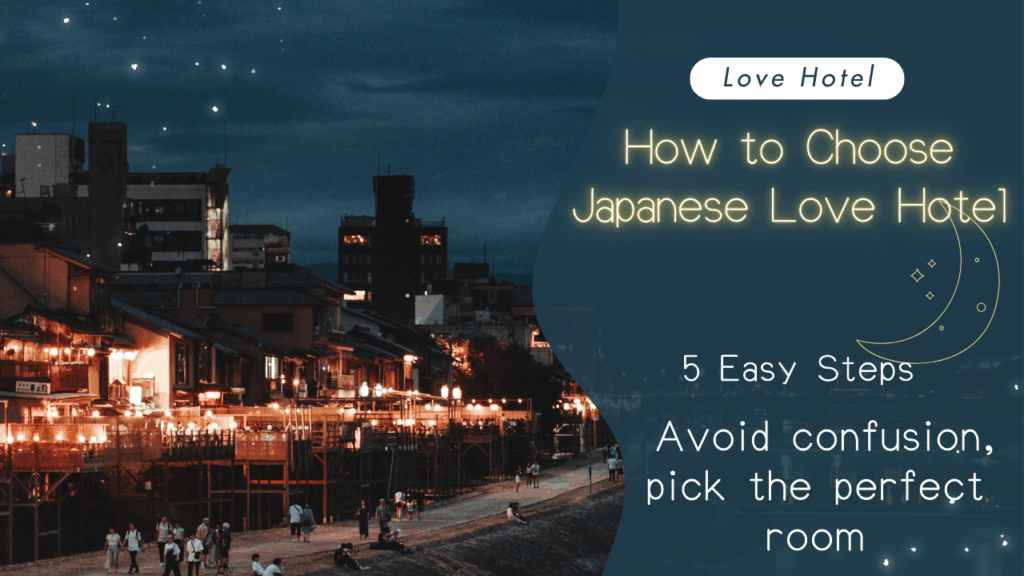Read this and book tonight. If you’re curious about Japan’s love hotels—famous for privacy, flair, and romance—but you’re worried about language barriers or making a misstep, this comprehensive guide is your ticket to confidence. We’ll walk you through the full journey: from pricing breakdowns to selecting the perfect themed room, and even how to exit like a seasoned guest.
Table of Contents
- Reading the Price Display
- Choosing a Room Type
- Using the Automatic Payment Machine
- Soundproofing Check
- Check-Out Process
Reading the Price Display
At first glance, love hotel pricing boards in Tokyo might seem overwhelming. But they follow a consistent logic that’s easy to understand once you learn a few key terms. Here’s what to look for:
Key Terms to Know
- Rest (休憩 / Kyūkei): A short stay, typically 1–3 hours. Available during the day or early night.
- Stay (宿泊 / Shukuhaku): An overnight stay, usually beginning after 10:00 PM and ending by the following morning.
- 延長料金 (Extension Fee): Charged if you exceed your allotted Rest or Stay time, usually in 30-minute increments.
| Plan | Japanese | Typical Duration | Available Times | Price Range |
|---|---|---|---|---|
| Rest (Short Stay) | 休憩 (Kyūkei) | 1–3 hours | Usually daytime or until late night | ¥3,000–¥5,000 |
| Stay (Overnight) | 宿泊 (Shukuhaku) | 8–12 hours | After 10 PM until morning | ¥5,000–¥15,000 |
Prices vary by room quality, day of the week, and time of entry. Weekends and holidays (金・土・祝前日) are often more expensive.
Time Confusion: What Does 25:00 Mean?
Japan sometimes uses a 24+ hour system. If you see a time like 25:00, don’t panic—it simply means 1:00 AM the next day. This system is common in nightlife contexts.
Example Pricing Board (Visual Guide Suggested)
A typical board might list multiple prices for different time blocks, with clear separation between “REST” and “STAY” sections. Always check the time slots to avoid surprise fees.
Choosing a Room Type
Love hotels are known for their creative rooms. Once inside the building—usually through a side or covered entrance—you’ll encounter a room selection panel, often near the lobby or entryway. Here’s how to choose wisely:
The Room Panel Explained
- Backlit Photos: Lit-up images = Available rooms.
- Dark Photos: Already occupied.
- Press the button below your chosen photo.
- A key or ticket will be dispensed.
Some hotels route you straight to your room via private elevators, and the first digit of the room number usually indicates the floor.
Room Features: From Basic to Fantastical
- Budget Rooms: Clean, simple décor, king-sized bed, TV (with free adult content), air conditioning, and basic amenities.
- Mid-Range: Add-ons like karaoke systems, jet baths, LED mood lighting, and themed interiors.
- Luxury Suites: Think rotating beds, ceiling mirrors, full jacuzzis, gaming consoles, or jungle and fantasy motifs.
Want cosplay options or themed lighting? Go for a mid-to-high-tier room. Even standard options often surprise guests with their attention to comfort and privacy.
Tip for First-Timers
If multiple rooms appeal to you, base your decision on picture quality and décor style. High-end rooms have more elaborate design elements, while cheaper ones keep it minimalistic.
Using the Automatic Payment Machine
The hallmark of love hotels: discretion. Most love hotels operate with minimal to no human contact. Here’s how payment typically works:
Types of Payment Systems
- In-Room Machines
- Usually located near the door or bedside.
- Insert cash or card (if accepted).
- Displays charges and extension fees.
- Lobby Kiosks
- Accepts tickets given at room entry.
- Allows you to settle payment before exit.
- Counter Payment (Behind Glass)
- Traditional style: No face contact, just a tray for money exchange.
Most modern systems are foreigner-friendly, with multilingual instructions or pictograms.
Payment Timing
- Prepaid Plans: Often for Rest. Just leave when done.
- Postpaid Plans: Usually for Stay. Pay before exit.
Some hotels lock your room door until payment is processed—don’t worry, this is standard. Press the “call” button if you need help.
Soundproofing Check
Privacy isn’t just visual—it’s acoustic. Japanese love hotels are designed to keep your activities strictly between you and your partner.
How Soundproof Are They?
- Walls & Doors: Typically thick, insulated.
- Windows: Often small or non-existent.
- Double Door Entry: Common in better hotels for noise containment.
Want to be sure? Do a quick test:
- Turn on the TV at a medium volume.
- Step into the hallway or ask your partner to.
- No sound escaping? You’re good.
Discretion to the Extreme
Some elite hotels even offer fake phone booths with train station background noise—helping guests make alibi calls.
Use background music or white noise in the room if you’re extra cautious. But in most cases, complete soundproofing is part of the deal.
Check-Out Process
Leaving your love hotel should be just as smooth as entering it. Here’s what you need to know:
Exit Types
- Automatic Unlock: For in-room payment systems.
- Key Drop Box: Leave your key on departure if prepaid.
- Counter Payment: If required, use the frosted-glass tray system.
Always look for exit signage or instructions in the room. Most hotels make it as anonymous and easy as possible.
If You Drove
- Parking Garages: Many love hotels have private parking.
- Exit Systems: Sensors, gate codes, or validation through room payment.
Forgot to Pay? You Might Be Locked In
It’s common for some hotels to lock the room door until full payment is made. Don’t worry—just pay using the machine or contact the front desk. They’ll unlock it remotely once payment is confirmed.
When done, grab your things (including phone chargers!) and head out—no formal checkout desk needed. You probably won’t see a single staff member.

FAQ: Love Hotels in Japan
1. Do I need to make a reservation at a love hotel?
No reservation is usually needed. Most love hotels operate on a walk-in basis. Just check the availability board and select an open room.
2. Can foreigners use love hotels in Japan?
Absolutely. Love hotels are open to anyone over 18. Many hotels in Tokyo are foreigner-friendly and include English signage.
3. Is it okay to go alone?
Yes, but it’s rare. While love hotels are mainly for couples, solo guests (especially male) are generally accepted unless explicitly prohibited.
4. Can same-sex couples stay at a love hotel?
Yes. Most love hotels don’t discriminate as long as guests follow rules. However, it’s wise to avoid hotels with signs saying “men only” or “no two males.”
5. Are love hotels safe?
Very. They offer privacy, clean facilities, and secure payment systems. Most rooms lock automatically, and you rarely see staff.
6. What should I bring?
Not much. Rooms come with toiletries, condoms, and often extras like hair products or bathrobes. You’ll just need your wallet and phone.
7. Do they accept credit cards?
Many do, especially in Tokyo. Look for card logos on the payment machine or ask (signs often indicate cash/card).
8. Can I leave and come back during my stay?
Usually no. Love hotels are meant for continuous use. If you leave, the door may lock or you may need to pay again.
9. Is food or room service available?
Yes. Some love hotels offer in-room dining via menu and phone system. Food may range from snacks to full meals.
10. What’s the difference between a love hotel and a regular hotel?
Love hotels prioritize privacy and short stays. They’re more themed, often more affordable, and designed for intimacy—without the formal check-in/out process.



